Dell 2407WFP and 3007WFP LCD Comparison
by Jarred Walton on March 2, 2007 11:30 AM EST- Posted in
- Displays
Brightness and Contrast Comparisons
For testing, we used a Monaco Optix XR (DTP-94) colorimeter on the hardware side. For software, we used Monaco Optix XR Pro. The software and hardware are relatively easy to use and together they help users fine tune their displays. Before we get to the calibrated results, we took a quick look at how the displays performed at minimum and maximum brightness. Note that we retested all of the displays here for this article, as we adjusted our testing procedures slightly in order to make sure we were providing the most consistent results possible. If you refer back to our previous Gateway FPD2485W article, you'll notice slight differences in the scores we are reporting today.
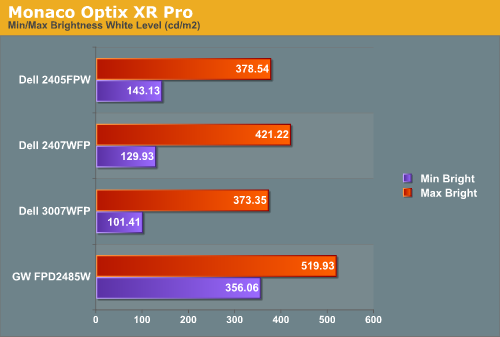
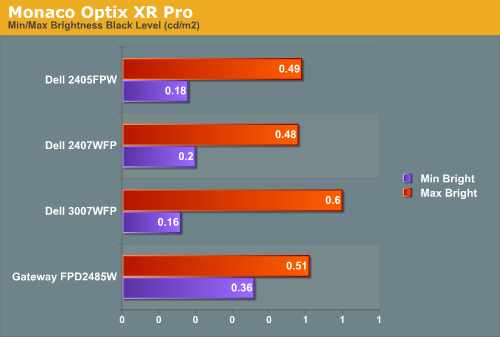
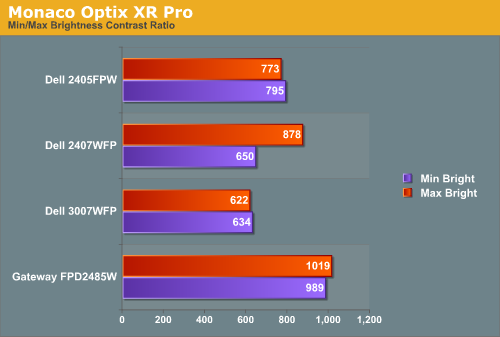
All three of the Dell LCDs are relatively consistent in terms of brightness levels and contrast ratios. The Gateway FPD2485W on the other hand is clearly brighter than the other LCDs, and it also has a higher contrast ratio. As we mentioned in the Gateway review, however, looking at these numbers really doesn't tell you a whole lot about how a display really performs. In the case of the Gateway LCD, even at minimum brightness it can feel overly bright in some environments. Now let's take a look at the brightness levels and contrast ratios once we've calibrated the LCDs.
We did find that the Monaco Optix XR Pro instructions tend to be a bit aggressive in terms of setting the contrast ratio, but both of the Dell LCDs we're looking at today don't provide an option to adjust contrast. For reference, the Gateway LCD was set to a 60% contrast ratio instead of 100% as the reduced contrast level generated slightly better overall results.
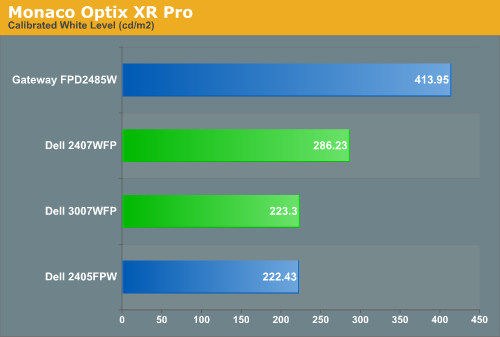
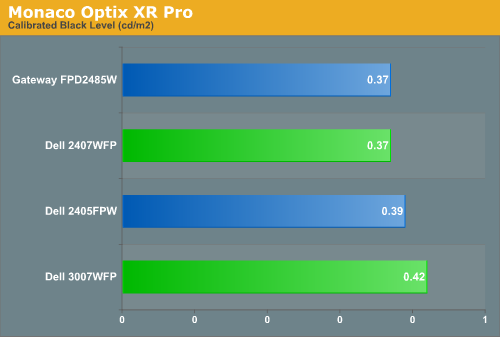
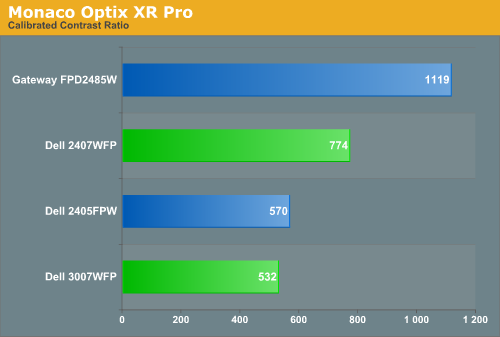
Comparing the calibrated versus min/max brightness, it should be immediately apparent that for most uses you will want to turn down the brightness level. As we'll see on the next page, you can still get good color accuracy even with a bright display, but if you use your computer for long periods at a time a display that's too bright can cause headaches and other annoyances. Theoretically, you want your whites to be brighter and your blacks to be darker, but brighter whites are only good up to a certain point. Anything above 400 cd/m 2 is far too bright in our opinion, and we found all three Dell LCDs tended to feel a bit easier on the eyes. Personal preference will still play a role, however, so if you find that you like really bright displays you might prefer the Gateway LCD.
For testing, we used a Monaco Optix XR (DTP-94) colorimeter on the hardware side. For software, we used Monaco Optix XR Pro. The software and hardware are relatively easy to use and together they help users fine tune their displays. Before we get to the calibrated results, we took a quick look at how the displays performed at minimum and maximum brightness. Note that we retested all of the displays here for this article, as we adjusted our testing procedures slightly in order to make sure we were providing the most consistent results possible. If you refer back to our previous Gateway FPD2485W article, you'll notice slight differences in the scores we are reporting today.



All three of the Dell LCDs are relatively consistent in terms of brightness levels and contrast ratios. The Gateway FPD2485W on the other hand is clearly brighter than the other LCDs, and it also has a higher contrast ratio. As we mentioned in the Gateway review, however, looking at these numbers really doesn't tell you a whole lot about how a display really performs. In the case of the Gateway LCD, even at minimum brightness it can feel overly bright in some environments. Now let's take a look at the brightness levels and contrast ratios once we've calibrated the LCDs.
We did find that the Monaco Optix XR Pro instructions tend to be a bit aggressive in terms of setting the contrast ratio, but both of the Dell LCDs we're looking at today don't provide an option to adjust contrast. For reference, the Gateway LCD was set to a 60% contrast ratio instead of 100% as the reduced contrast level generated slightly better overall results.



Comparing the calibrated versus min/max brightness, it should be immediately apparent that for most uses you will want to turn down the brightness level. As we'll see on the next page, you can still get good color accuracy even with a bright display, but if you use your computer for long periods at a time a display that's too bright can cause headaches and other annoyances. Theoretically, you want your whites to be brighter and your blacks to be darker, but brighter whites are only good up to a certain point. Anything above 400 cd/m 2 is far too bright in our opinion, and we found all three Dell LCDs tended to feel a bit easier on the eyes. Personal preference will still play a role, however, so if you find that you like really bright displays you might prefer the Gateway LCD.










62 Comments
View All Comments
Resh - Saturday, March 3, 2007 - link
Thanks Jarred!I wouldn't expect you to print and assess accuracy, but if you could do a photo-specific calibration and test for future reviews, that would be great.
Thanks again and keep up the good work!
BPB - Friday, March 2, 2007 - link
I have two questions. In the Gateway review you mentioned the Gateway did a good job of showing 16:9 movies with the black bars and that the Gateway did 1:1 very well. You also mentioned that you heard the Dell maybe didn't do it as well. So the first question is: did you try this in your test? I just bought the Gateway and like it (I opened the box last night, hours before you posted this review), but I plan on using it to watch DVD's while I work out, as well as using it as my main monitor.The second question is does the Dell have auto-rotate software like Gateway's EzTune? I was told by a Dell rep that it doesn't and that you have to manually change the video drivers. I like to use rotate when working on a website. I can often fit an entire site up and down when rotated. At most I have to scroll very little.
Oh well, looks like I may have to beg BestBuy to take the FPD2485W back and head up to Costco for the Dell if the Dell does DVD's as well. Of course then the Dell would be a little more as I didn't pay tax or shipping for the Gateway (thanks, NH!) but would have to pay tax for the Dell (arghh to you, MA) making the $5 list price favor of the Dell become a $28.70 favor for the Gateway. I paid $679.99 for the Gateway, the Dell becomes $707.70 with tax.
JarredWalton - Friday, March 2, 2007 - link
Dell locks the scaling to what your drivers specify if you use DVI. ATI doesn't allow 1:1 scaling as far as I know, but they do allow a centered 1:1 image (i.e. black bars). NVIDIA has better options for changing scaling, although I have encountered bugs in the past with their 1:1 scaled option. The Gateway does have controls more like the old 2405FPW (where you could set scaling via the monitor rather than in drivers), but the colors aren't as good overall. In terms of DVD playback, neither display is really good (i.e. less than 3 delta E), and I don't know that subjectively I can see a big difference between the Dell and GW when watching videos. You can always disable DirectDraw to get the color profile applied (it disables overlay)... heh.JarredWalton - Friday, March 2, 2007 - link
Oh, I forgot to say, I don't think there's an auto-rotate software with the Dell. Also, I'm not sure EZtune handles the auto-rotate - I thought it was a function of the drivers, but I could be wrong. I'll have to test it later... right now I need sleep! ;)BPB - Friday, March 2, 2007 - link
Thanks for the quick reply. I had a Gateway 21" before getting the 24" and can attest to the EzTune doing the auto-rotate. It's a very nice feature. Not a deal-breaker type of thing, but it's nice. When I consider the effort it will take to return the Gateway to get the Dell I start to think it probably ain't worth it, the effort, that is.chizow - Friday, March 2, 2007 - link
The 2407WFP REV A04 does 1:1 scaling. It looks like Jarred got an A03 or earlier for the review. I saw the 1:1 scaling option greyed out in the OSD but didn't see it directly mentioned in the review anywhere.Jarred, you gotta include this kind of stuff in your reviews! Its what panel buyers want to know. Also was the 3007 the HC version or standard?
Otherwise nice review; the difference between the 2407 and the FPD2485W is spot-on with my own observations from using both first hand. The one test I felt was flawed was comparing the 2405 and 2407 for input lag. A better test imo would've been testing the 2407 to the FPD2485W or even a 2ms TN or S-IPS. IIRC the 2405 had input lag problems as well, so any lag wouldn't really show when comparing the two.
JarredWalton - Friday, March 2, 2007 - link
I'll see about taking a shot of the FPD2485W vs. 2407WFP for input lag - again, I've never had any issue, but maybe I'm just getting too old and my eyes are slow? :)The LCD I have is revision A01, so some things have apparently changed. Sort of interesting, as I have only had the LCD for a few months... I would have expected something made more recently. I guess Dell hasn't made a point of pushing newer revisions, which isn't too surprising. The 3007 is the standard version as far as I can tell - wouldn't the new HC be a separate model, or are they simply phasing out the older IPS model and moving to a TN or whatever version instead?
chizow - Friday, March 2, 2007 - link
I didn't think it would be that big of a deal either, but after having used both, it is slightly noticeable. Part of it might be psychological, but there's some pretty convincing tests out there that show the input lag can be pretty severe. Similar to your test, they had side-by-side screens where ammo counters were off by 1-2 rounds, objects were in different positions, and other anomalies.Wow A01, surprised it didn't exhibit more serious banding problems. Maybe it was a refurb? The A01 and A02 were supposed to exhibit banding problems similar to the Gateway. But ya Dell is horrible with their panel lottery; if they shipped you guys a panel gratis it was probably a refurb or recycled panel. Makes a lot of sense shipping an old panel to a well-known review site!
The HC is being treated as a new revision afaik. Its been in Asian markets since the new year and has only become available in the US recently to select customers. I think it will eventually just replace the older versions in the channel when it reaches widespread availability. I'm also pretty sure its still IPS, it just increases brightness/contrast since that was the biggest knock on the 3007 apparently.
BPB - Friday, March 2, 2007 - link
I just saw your reply in the forums. Thanks!BPB - Friday, March 2, 2007 - link
So you too would recommend the Dell over the Gateway? If so, would you say like Jarred that the difference is minimal or would you say it's more than minimal?